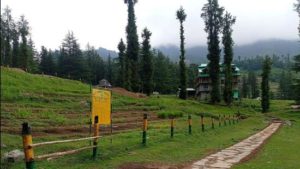
The valley of Bhulah is ready to make its contribution towards the conservation of the endangered Himalayan herbs. Along with helping researchers to conduct in-depth research, the park will also prove as a special attraction for tourists from across the globe.
The state’s first Biodiversity Park established at a cost of Rupees one crore at Bhulah in Janjehli Valley of District Mandi would prove to be a boon for researchers and tourists along with conservation of the endangered Himalayan herbs.
Realizing the vision of Chief Minister Jai Ram Thakur, this first Biodiversity Park in the state has been created under the National Mission on Himalayan Studies (NMHS) project by HP Forest Department. This is the first park in the state in which emphasis has been laid on conservation of endangered herbs. The park has been designed to link tourism activities alongwith providing new opportunities for researchers to conduct in-depth exploration on various medicinal herbs found in the Himalayas that are on the verge of extinction.
Herbal nursery to conserve herbs that are about to extinct in the mountains has been set up for display in the park. In this nursery, Trillidium Govanianum (Nagchhatri), Dhoop, Picrorhiza kurroa (Kadu), Sarpagandha, Swerlia Chiryita (Chirayita), Barbari, Angelica glauca (Chaura), Coleus gromalicus (Pathanbel), Pathar chata, Selinum vaginatum (Bhutkesi), Nyar, Valeriana Wallichi (Mushkwala), Thymus Linearis (Van Ajwain), Kuth, Acorus Calamus (Barre), Asparagus (Sansarpali), Potentilla Nepalensis (Dori Ghass), Ratan Jot, Aconitum heterophyllum (Atish Patish), Padophyllumhexandrum (Van Kakdi), Dioscorea delloidea (Shingli Mingli), Jangli Lahsun, Adiantum lunulatum (Dungtuli), etc. have been displayed.
Any research scholar from the country or abroad can avail information about the herbs to conduct research work. In this herbal nursery, about 1200 plants of different species are available for the researchers.
This fenced park has been built on five hectares i.e. more than 60 bighas of land and made safe for visitors. Various basic facilities have also been mobilized here for researchers. Various works of NMHS project have been done on about 15 hectares of land.
Amphitheaters have also been built in the park for the convenience of the researchers and tourists visiting the nursery and obtain information. Apart from this, two log huts, water harvesting structure, internal tank, 5 KW power generation project, bird nest, foot-bridge and sales center etc. have also been setup.
Two tree-huts have also been prepared in the park for the tourists, from where they can enjoy picturesque view of the park. Nature trails of about 2 Kilometers, 25 feet high and 160 meters long tree-walk has been prepared and seven foot bridges have also been built.
In its endeavour to make Himachal the most preferred destination for tourists from across the globe many initiatives have been taken by the state government. This Biodiversity park is a part of the initiative of the state government to explore tourism potential of lesser known areas of Himachal Pradesh. This park is in resonance of the State Government’s resolve to promote cultivation and conservation of indigenous plants.
Read also:
- What is Deen Dayal Upadhyay Rural Skill Scheme?
- How is PM KISAN Yojna benefitting the people of Himachal?
- What is Mukhya Mantri Bal Suposhan Yojana?
- Himachal achieves 93.05 percent target of providing functional household connections under Jal Jeevan Mission
- What is HP SHIVA Project and how it is transforming Himachal into a fruit state?
- Know about the Present Status of Social Security Schemes in Himachal Pradesh